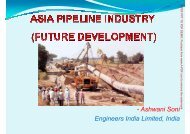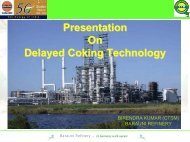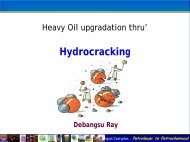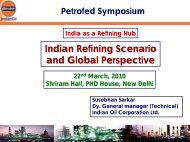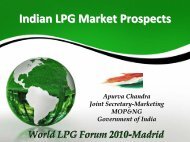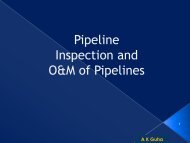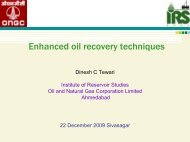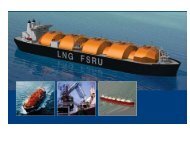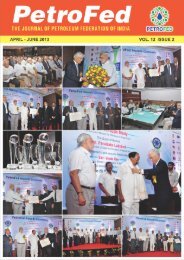Chapter -1 final last new font final - petrofed.winwinho...
Chapter -1 final last new font final - petrofed.winwinho...
Chapter -1 final last new font final - petrofed.winwinho...
You also want an ePaper? Increase the reach of your titles
YUMPU automatically turns print PDFs into web optimized ePapers that Google loves.
7<br />
www.<strong>petrofed</strong>.org<br />
offers potential advantages to the refinery in<br />
terms of the Hydrogen and steam balance,<br />
oil, with fewer secondary processing facilities.<br />
offering the possibility of releasing some of Refining operations by themselves contribute only<br />
the refinery streams for further value addition. a small portion of GHG emissions when compared<br />
with the emissions on account of fuel combustion<br />
The technologies envisaged in the above by the end users. Almost 80 % of CO2 emissions<br />
approach are well proven. Liquid fuels derived are on account of fuel combustion, while about<br />
from the FT process have been produced since 10-12% is contributed by refining. There is little<br />
before World War II. Sasol have been using low that can be done to lower the CO2 emissions from<br />
grade coal to produce fuels since the 1950's via fuel combustion, unless we move to a scenario in<br />
this route and today, a number of projects for which refining operations are altered such that the<br />
power and Chemicals generation are at different end product from the refinery is Hydrogen. In such<br />
stages of implementation in China. Majors like a scenario 100% of the carbon contained in the<br />
Sasol Exxon Mobil, Shell and Conoco have carried crude oil would be released as CO2. On paper,<br />
out developments in the FT synthesis process- the saving grace of such an alternative is that it<br />
concentrating on reactor and catalyst related offers the possibility of capturing all the CO2 at a<br />
issues for improvements in selectivity and plant single location. This is presently a remote<br />
economics. scenario, but it does help to point out that in our<br />
pursuit of compliance with clean fuel quality, we<br />
Variation in Crude Oil price by about $ 20/bbl can are in effect generating increasing quantities of<br />
seriously impact the return on investment for a Carbon Dioxide and need to intensify efforts to<br />
CTL project based on the FT route. Given the reduce GHG emissions. These efforts offer the<br />
nature of investments involved in the GTL /CTL following benefits:<br />
options, it is imperative to carry out detailed site<br />
specific studies to establish the viability under<br />
different scenarios of Crude oil and gas prices. The<br />
same would apply for processes involving direct<br />
coal liquefaction through Hydrogen addition.<br />
Considering the position of coal reserves and the<br />
•<br />
•<br />
Lower Energy Costs – it makes good sense<br />
environmentally and economically to use<br />
energy more efficiently and simultaneously<br />
reduce or eliminate GHG missions.<br />
Extend the world's energy resources<br />
need to utilize them to the maximum extent, it may<br />
not be far fetched to think in terms of a “coal<br />
“refinery in future.<br />
•<br />
•<br />
Meet and beat the competition to provide<br />
better product quality<br />
Meet rising expectations for <strong>new</strong> products,<br />
With the availability of Gasification, another<br />
<strong>new</strong> technologies.<br />
potential linkage between refinery and<br />
gas/petrochemicals offers itself for consideration.<br />
Figure 3 indicates how this could be done.<br />
Optimization of CO2 emissions presents refiners<br />
with a real challenge, particularly where<br />
emissions trading schemes have been introduced.<br />
Green house gas emissions and abatement<br />
Some of the areas in which a charge for CO2<br />
emissions can drive changes in refinery operations<br />
While the above are representative of the<br />
challenges and opportunities that can be met<br />
through the application of mature technology<br />
and even in the actual configuration selected for<br />
the refinery may involve a combination of the<br />
following:<br />
options, the flip side presents issues related to • Efficiency Improvement<br />
higher energy consumption and resulting increase<br />
in emissions of Carbon Dioxide. Increasingly<br />
stringent product specifications have addressed<br />
•<br />
•<br />
Crude and fuel substitution<br />
Residue upgrading<br />
issues related to SOx, NOx, Volatile Organic<br />
Compounds and Particulate Matter through a<br />
combination of modification in the molecular<br />
•<br />
•<br />
Hydrogen production<br />
Carbon sequestration<br />
structure of the fuels and an increase in their<br />
Hydrogen content through the application of a<br />
• Modeling CO2 in LP<br />
suite of processes that are well established. The issues that have been discussed in the<br />
Carbon Dioxide, however remains a major issue. foregoing sections give a pointer to what lies<br />
It is not simple to track refining green house gas ahead and the future could see a lot of emphasis<br />
generation, but it can be assumed that processing on some of the following:<br />
of heavier and sour crude oils is expected to result<br />
in a major increase of GHG emissions as<br />
compared to a refinery based on light sweet crude<br />
• Production of Bio fuels that have higher<br />
energy densities than ethanol and bio diesel<br />
and are compatible with petroleum based




